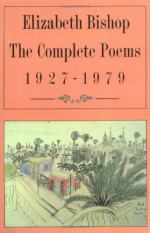
|
| Name: _________________________ | Period: ___________________ |
This test consists of 15 multiple choice questions and 5 short answer questions.
Multiple Choice Questions
1. Which word in lines 10 and 11, "And look! my last,/ or next-to-last, of three loved houses went," creates a momentary shift in verb mood?
(a) The word "next."
(b) The word "look."
(c) The word "went."
(d) The word "loved."
2. What is used for the first time in the poem's final stanza?
(a) Parenthetical expressions.
(b) Modifying phrases.
(c) Sentence fragments.
(d) Coordinating conjunctions.
3. Lines 4 and 6, ending in the words "fluster" and "master," exhibit what type of rhyme?
(a) Perfect rhyme.
(b) Slant rhyme.
(c) Internal rhyme.
(d) Eye rhyme.
4. Which is the best description of the tone of stanza one?
(a) Bewildered.
(b) Livid.
(c) Sanguine.
(d) Ebullient.
5. What is the most reasonable interpretation of the speaker's line 13 claim that they have "lost two cities"?
(a) The speaker no longer lives in either city.
(b) The speaker is no longer interested in either city.
(c) The speaker cannot find either city.
(d) The speaker is not welcome in either city.
6. How many lines does "One Art" have?
(a) 19.
(b) 18.
(c) 20.
(d) 17.
7. What is the name of the metrical foot that appears at the end of lines 1 and 3 in most of the stanzas?
(a) Amphibrach.
(b) Anapest.
(c) Dactyl.
(d) Tribrach.
8. Stanzas four through six have which techniques in common?
(a) Second person and imperative mood.
(b) First person and imperative mood.
(c) First person and indicative mood.
(d) Second person and indicative mood.
9. How many stanzas does "One Art" have?
(a) 7.
(b) 8.
(c) 6.
(d) 9.
10. In line 7, "Then practice losing farther, losing faster," rhythm is created through which devices?
(a) Cacophony, epizeuxis, and diazeugma.
(b) Parallelism, diacope, and consonance.
(c) Alliteration, epistrophe, and antithesis.
(d) Anaphora, assonance, and asyndeton.
11. How many refrains does "One Art" contain?
(a) 4.
(b) 1.
(c) 2.
(d) 3.
12. In lines 2 and 3, "so many things seem filled with the intent/ to be lost that their loss is no disaster," what is the antecedent of the word "their"?
(a) Things.
(b) Intent.
(c) Many.
(d) Lost.
13. What is the meaning of the word "fluster" in line 4?
(a) Confused agitation.
(b) Humorous coincidence.
(c) Sudden, uncoordinated movement.
(d) Tiring inconvenience.
14. What kind of metrical foot is the most frequent in "One Art"?
(a) Iamb.
(b) Trochee.
(c) Spondee.
(d) Dibrach.
15. What does the speaker use in line 5 as an example of a common lost object?
(a) Glasses.
(b) Pens.
(c) Keys.
(d) Socks.
Short Answer Questions
1. Who is the author of "One Art"?
2. The relationship between stanza two and stanza three is most accurately expressed by which of the following?
3. Which technique is used in the speaker's claim to have lost "some realms I owned, two rivers, a continent" (line 14)?
4. What is the verb mood of line 4, "Lose something every day"?
5. In line 10, what does the speaker admit to having lost?
|
This section contains 485 words (approx. 2 pages at 300 words per page) |

|




